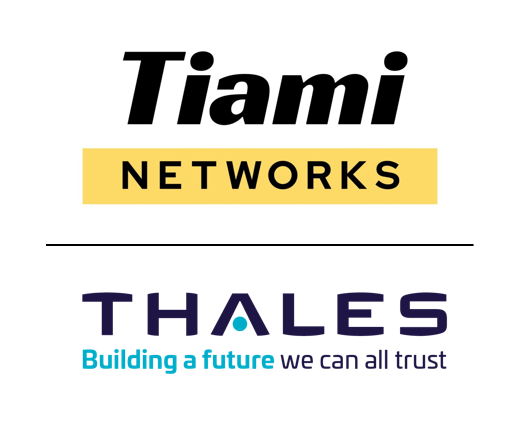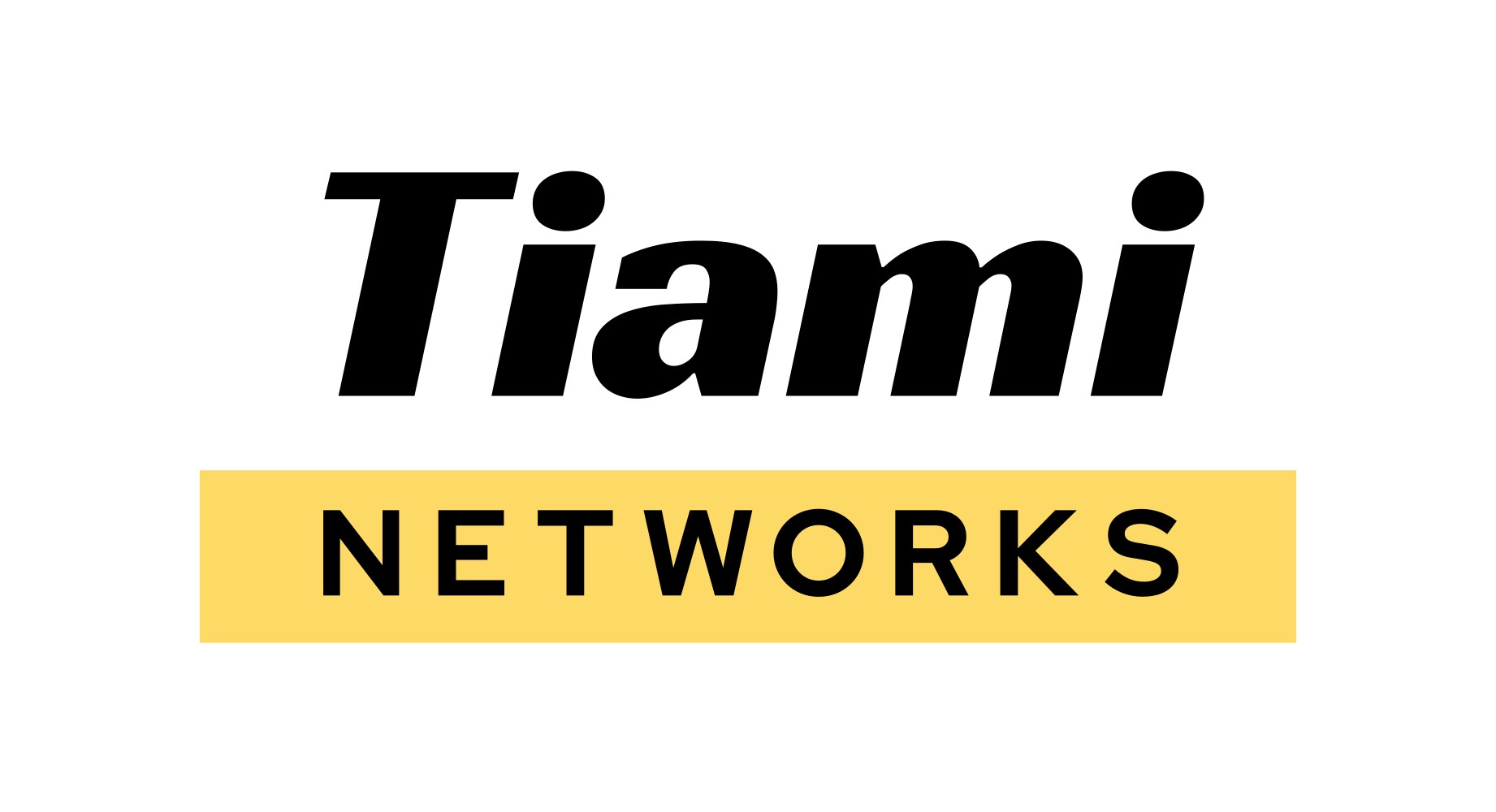Tiami Networks Announces Strategic Collaboration to Transform 5G Networks
February 22, Elk Grove, California – Today, Tiami Networks announces a strategic collaboration with Intel, a leader in computing innovation. This collaboration marks a significant milestone in Tiami Networks’ quest to revolutionize 5G technology, transforming global 5G networks into the world’s largest radar system.
“Elk Grove is proud to be at the forefront of this technological leap. Piloting PolyEdge™ for traffic flow monitoring is not just about embracing innovation; it’s about actively contributing to a smarter, safer, and more efficient community,” commented Darrell Doan, Economic Development Director, Elk Grove, California.
A New Era of Connectivity: AI + 5G + Radar on Edge Devices
The collaboration with Intel is pivotal in the development of PolyEdge ™, Tiami Networks’ cutting-edge technology that combines AI, 5G, and radar capabilities on edge devices. Tiami employs state-of-the-art 5G signal processing and proprietary machine learning algorithms for sensing, enhanced by Intel’s cutting-edge FPGA artificial intelligence framework.
This innovative approach is set to redefine connectivity and data analysis, promising significant advancements in areas like public safety, environmental monitoring, and smart city initiatives. By providing real-time data analysis, PolyEdge ™ can help in efficient resource allocation, emergency response optimization, and even tracking environmental changes with unprecedented accuracy.
“Intel is excited to see Tiami Networks utilize our technology in a transformative way. This collaboration showcases the versatility of Intel’s FPGA artificial intelligence solutions and paves the way for groundbreaking advancements in 5G capabilities,” said Mike Fitton, Network Business Division, Intel.
Looking Ahead
This collaboration represents a leap forward in technological integration, combining the strengths of Tiami Networks’ innovative vision and Intel’s robust technological infrastructure. The initiative is poised to set new standards in connectivity and data analysis, offering transformative solutions for cities, industries, and societies worldwide. “This collaboration with Intel is a game-changer. It enables us to bring our innovative technology to market, transforming the way we understand and interact with our environment. We’re creating a new paradigm where 5G networks do more than connect – they perceive and respond.”, said Amitav Mukherjee, CEO of Tiami Networks
Connect and Learn More
Tiami Networks will be showcasing PolyEdge™ at Mobile World Congress in Barcelona from 26-29 February, 2024. Stop by Stand #6F48 and experience the future of 5G.
About Tiami Networks
Founded by seasoned professionals from renowned telecom giants such as Ericsson, Verizon, Qualcomm, and Nokia, Tiami Networks is a visionary startup based in California. With deep-rooted expertise in telecommunications, our team is dedicated to revolutionizing the global 5G landscape. Our mission is to transform the 5G system into the world’s largest distributed radar network, harnessing this technology for consumer and commercial applications. By integrating advanced AI and radar technology with 5G networks, Tiami Networks aims to create smarter, safer, and more efficient environments, enhancing connectivity and data analysis capabilities across various sectors. Our commitment to innovation positions us at the forefront of the next wave of technological advancements, poised to redefine the future of communication and environmental intelligence. Learn more at www.tiaminetworks.com
About Intel
Intel (Nasdaq: INTC) is an industry leader, creating world-changing technology that enables global progress and enriches lives. Inspired by Moore’s Law, Intel continuously works to advance the design and manufacturing of semiconductors to help address our customers’ greatest challenges. By embedding intelligence in the cloud, network, edge and every kind of computing device, Intel unlocks the potential of data to transform business and society for the better. To learn more about Intel’s innovations, go to newsroom.intel.com and intel.com.
For more information, please contact:
Tiami Networks
Mr. Tyrell Junius
Email: tjunius@tiaminetworks.com
Intel
Mr. Bret Gustafson
Email: bret.gustafson@intel.com
Recent Blogs
The State of Integrated Sensing (ISAC) in 5G Standards
As wireless networks evolve beyond connectivity into intelligent infrastructure, Integrated Sensing and Communications (ISAC) has emerged as a critical technology pillar. By using the same waveforms and infrastructure to both transmit data and sense the environment, ISAC transforms traditional communications networks into multifunctional platforms capable of enabling everything from smart cities to autonomous systems. ISAC is emerging as the linchpin for secure, intelligent infrastructure in an era of adversarial threats, dense urbanization, and automated mobility.
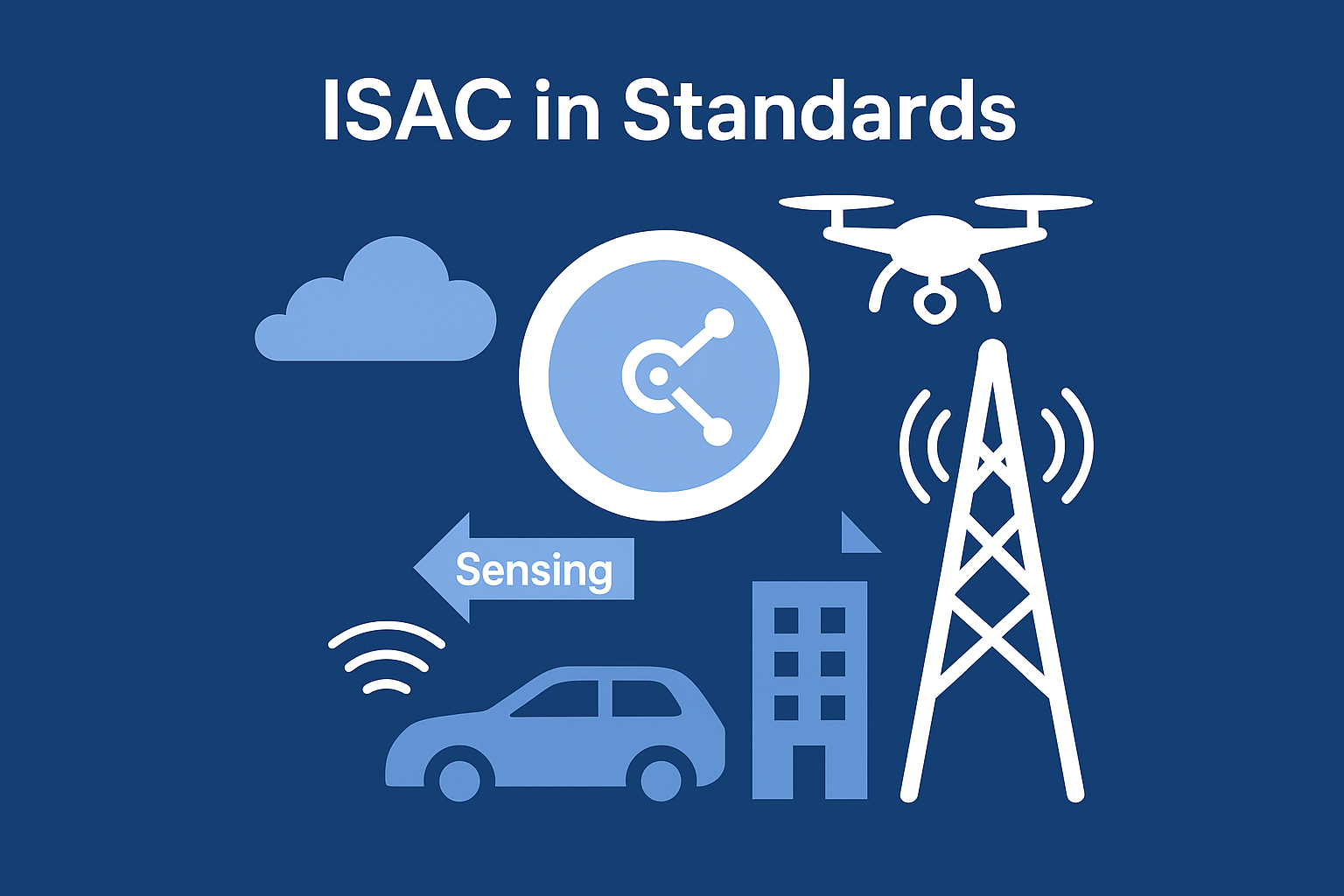
Why ISAC Matters Across Industries
As Integrated Sensing and Communications (ISAC) moves from concept to deployment, its value is being recognized across multiple sectors - not just for what it enables technically, but for the operational and strategic advantages it brings.
For Telecom Operators: ISAC reduces both capital and operating expenses by combining sensing and communications on shared infrastructure. Instead of deploying separate radar or camera systems, telcos can use their existing 5G networks to monitor environments, detect anomalies, and gather real-time insights. This convergence lowers deployment costs (CAPEX), streamlines network maintenance (OPEX), and opens the door to new sensing-as-a-service revenue models.
For the Public Sector: ISAC enhances situational awareness by enabling passive, real-time monitoring of people, vehicles, and drones - even in GPS-denied or low-visibility environments. Governments and agencies can leverage commercial wireless infrastructure to improve surveillance and safety, especially in applications like border security, emergency response, and critical infrastructure protection.
For Automotive OEMs: ISAC complements onboard vehicle sensors by providing environmental awareness beyond line-of-sight - detecting objects through occlusions and providing context via the network itself. This additional sensing layer supports safer autonomous driving and more robust ADAS (Advanced Driver Assistance Systems), especially in complex urban environments where traditional sensors alone may struggle.
In short, ISAC isn’t just a technical upgrade - it’s a strategic enabler for cost savings, safety, and innovation. But where exactly does ISAC stand in the formal wireless standards today? And how close are we to mainstream deployment?
ISAC in 5G and 5G Advanced
While early 5G rollouts focused largely on enhanced mobile broadband and low-latency applications, the concept of integrating sensing capabilities into the network has steadily gained traction. The 3rd Generation Partnership Project (3GPP), which defines global wireless standards, in Release 18, initiated a Study Item on Radio-based Positioning Enhancements, setting the stage for advanced localization without dependency on the global navigation satellite system (GNSS) for 5G-Advanced.
In Release 19, now in progress, ISAC is gaining sharper focus. The 3GPP Service & System Aspects Work Group 1 (SA WG1) published a technical report and a specification covering ISAC use cases, including 32 use cases, and requirements.
Topics under discussion include:
• Deployment scenarios, including target classification and communication environment
• Channel modeling
The work remains in the study phase, but the foundation is being laid for future Work Items that would formally define ISAC features in later releases, likely timed with the transition toward 6G.
Looking Ahead to 6G
European Telecommunication Standard Institute (ETSI) Industry Specification Group (ISG) ISAC leads pre-standardization work aimed at advancing ISAC for 6G systems. The group is developing a roadmap focused on sensing use cases that extend beyond what is addressed in 3GPP Release 19, identifying those with the potential to influence future 6G deliverables from standardization bodies such as 3GPP, IEEE, and International Telecommunication Union-Radiocommunication Sector (ITU-R). A key activity is the development and validation of advanced radio channel models suited to both communications and sensing, including measurement campaigns and modeling of stochastic and deterministic scattering. In parallel, ISG ISAC is defining key performance indicators (KPIs) and their evaluation methods.
The group is also studying required architectural changes at both the system and radio access network (RAN) levels to support different levels of integration between sensing and communication, various sensing types such as monostatic or multistatic, deployment modes including downlink, uplink, and diverse node types such as TRPs, UEs, and non-3GPP devices.
The vision for 6G includes ISAC as a native capability. Industry roadmaps from major research alliances, such as the Next G Alliance in North America and Hexa-X in Europe, highlight joint communication and sensing as a cornerstone of 6G’s value proposition.
Anticipated features include:
• Centimeter-level accuracy for localization
• Sensing-aware network scheduling
• Radar-like capabilities integrated into base stations
The timeline for 6G standardization points to early 2030s deployments, with ongoing pre-standard research through the rest of this decade. What’s happening now, in 5G Advanced, is laying the crucial groundwork.
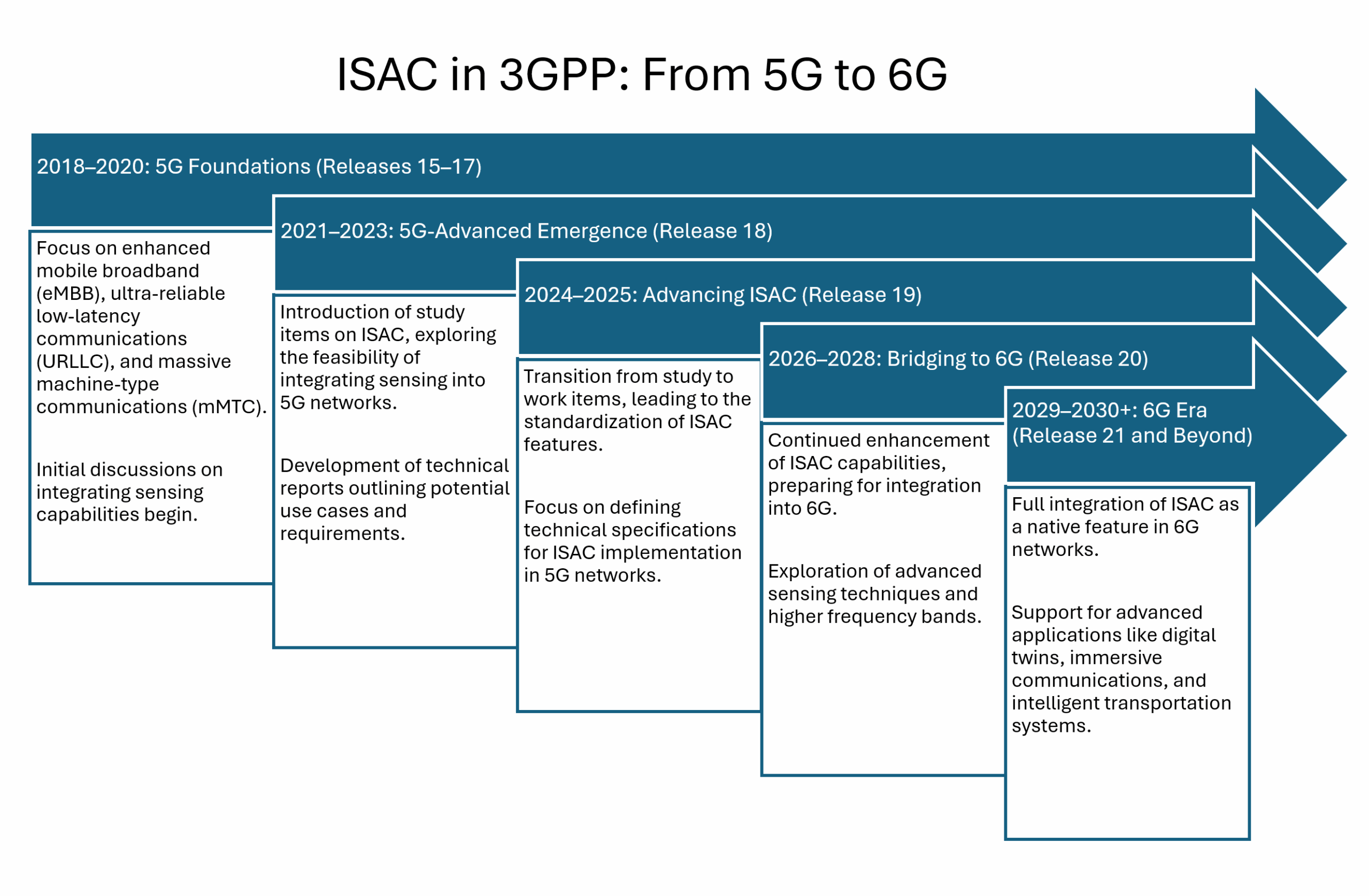
Strategic Implications of ISAC Standardization
The evolution of ISAC from 5G-A study items to 6G-native capabilities is not merely a technical shift - it signals a broader redefinition of how networks serve public infrastructure, defense, transportation, and smart environments. As standards bodies like 3GPP and ETSI formalize ISAC requirements, we anticipate a reshaping of multiple adjacent industries that depend on accurate sensing, situational awareness, and RF environment monitoring.
From a business standpoint, ISAC creates new commercial opportunities in verticals such as:
• Automotive and transportation, where RF-based localization can augment or replace GPS in urban or contested environments.
• Critical infrastructure and facility monitoring, enabling spectrum-aware intrusion detection and people counting without adding new hardware.
• Defense and aerospace, where low-SWaP (Size, Weight, and Power) sensors integrated into communications gear offer stealth and resiliency advantages.
Moreover, ISAC may disrupt existing sensor markets by absorbing sensing functions into communications infrastructure. For example, cellular base stations enhanced with ISAC may reduce the need for fixed LIDAR or radar units in urban sensing deployments. This will incentivize network operators to adopt ISAC-enabled hardware as a value-add and create demand for standards-compliant software layers such as Tiami Networks’ PolyEdge platform.
On the policy front, ISAC aligns with national initiatives around spectrum efficiency and infrastructure convergence.
We expect regulators to prioritize:
• Dynamic spectrum sharing policies, where sensing-aware networks adapt usage based on environmental awareness.
• Privacy-by-design regulations, requiring RF sensing to meet non-invasive, anonymized data handling standards.
• Cyber-physical integration guidelines, incorporating ISAC within frameworks like NIST’s National Cybersecurity Center of Excellence (NCCoE) or DHS CISA guidance for secure, intelligent infrastructure.
Finally, ISAC presents a key strategic lever in U.S. technological competitiveness, particularly in response to adversarial advances in electronic warfare, autonomous surveillance, and resilient mesh networking. Early standardization work - combined with commercially validated sensing - positions companies to influence how this capability is defined, governed, and exported globally.
Tiami’s Role in Advancing ISAC
While ISAC is still emerging within global standards bodies, Tiami Networks has been actively shaping its trajectory - not just through theoretical input, but through real-world deployment, experimentation, and validation.
Simulation Contributions to 3GPP: Tiami has shared simulation results and performance benchmarks with 3GPP working groups, providing early insight into the feasibility and effectiveness of passive sensing using commercial 5G infrastructure. These contributions help inform technical requirements and use case prioritization in the ongoing development of 5G-Advanced and beyond. (more on our contributions to 3GPP in the next section)
Field-Tested Deployments: Our PolyEdge™ Multifunction Sensor platform has been deployed across multiple testbeds, including military training environments, airports, and urban intersections. These live deployments validate key ISAC capabilities in real-world conditions - from passive radar-style sensing to environmental awareness and infrastructure monitoring.
Proven Use Cases: Tiami has already demonstrated ISAC’s practical value in applications like drone detection, low-altitude situational awareness, and camera-free occupancy sensing. These successes showcase the operational potential of ISAC today - not years from now - and reinforce the value of continued development across both public and private networks.
By contributing data, field results, and practical expertise to the global standards ecosystem, Tiami is helping ensure that ISAC evolves with a strong foundation in what actually works.
Tiami Networks and 3GPP
At Tiami Networks, we’ve been proud to contribute to 3GPP’s ongoing exploration of ISAC through participation in working group discussions and submission of technical input, including channel modeling considerations, details of the deployment scenarios, and providing simulation results for channel calibration. Our PolyEdge Multifunction Sensor is already proving that low-latency and real-time RF sensing is possible today using existing 4G and 5G waveforms, while compliant with the existing 3GPP RAN1 specifications, with applications ranging from drone detection to occupancy monitoring.
By building and validating these capabilities in real-world deployments, we aim to accelerate the standardization path and support a robust ISAC ecosystem across industries.
Closing Thoughts
ISAC is no longer a futuristic concept - it’s actively being shaped within today’s standards bodies and pilot deployments. While full native support in 5G networks is still on the horizon, the current momentum in 3GPP and among industry players makes it clear: sensing is becoming just as important as communicating. For now we invite industry, academic, and government partners to collaborate on deploying ISAC-ready sensing solutions today - and to shape the standards and applications of tomorrow.
We’re excited to continue helping define what that future looks like!
Tiami Networks and Thales Defense & Security, Inc. Sign Memorandum of Understanding to Advance 5G-Integrated Sensing for Defense and Government Applications
Tiami Networks (Tiami), a leader in AI-driven 5G sensing technologies, and Thales Defense & Security, Inc. (TDSI), a trusted provider of advanced tactical communications and defense technology, today announced the signing of a Memorandum of Understanding (MoU) to commence a strategic partnership. This collaboration marks a major step forward in the future of 5G-integrated sensing and defense technology.
By combining Tiami’s PolyEdge Multifunction Sensor software, which uses AI to passively sense and interpret the wireless environment, with TDSI’s deep expertise in tactical networking, radar, and mission-critical defense systems, the two companies aim to co-develop next-generation situational awareness capabilities. These joint solutions will target a range of applications across U.S. Department of Defense programs, government operations, and commercial markets where secure, real-time sensing and decision-making are paramount.
“This partnership with TDSI represents a powerful alignment of our advanced sensing capabilities with their world-class defense systems,” said Amitav Mukherjee, CEO of Tiami Networks. “Together, we’re shaping the future of multi-domain awareness by fusing FutureG RF sensing with robust, field-proven communications technologies.”
Through this relationship, the companies will explore integration pathways between Tiami’s edge-AI and 5G/Wi-Fi-based sensing platform and Thales' secure tactical communications architecture. Potential use cases include force protection, perimeter security, airspace awareness, and urban surveillance – all leveraging ambient wireless signals for reduced signature and jamming-resistant sensing.
“TDSI is excited to work alongside Tiami Networks to explore and operationalize multifunction sensing capability that complements today’s defense systems,” stated Paul D. Mehney, Vice President Strategy, Thales Defense & Security, Inc. “Partnerships with tech firms such as Tiami Networks allows for rapid and agile innovation in the defense sector.”
The MoU solidifies a shared commitment to innovation, resilience, and rapid deployment of AI-enhanced sensing solutions in mission-critical environments.
For more information, please visit www.tiaminetworks.com and www.thalesdsi.com.
About Tiami Networks
Founded by seasoned professionals from renowned telecom giants such as Ericsson, Verizon, Qualcomm, and Nokia, Tiami Networks is a visionary startup based in California. With deep-rooted expertise in telecommunications, our team is dedicated to revolutionizing the global 5G landscape. Our mission is to transform the 5G system into the world’s largest distributed radar network, harnessing this technology for consumer and commercial applications. By integrating advanced AI and radar technology with 5G networks, Tiami Networks aims to create smarter, safer, and more efficient environments, enhancing connectivity and data analysis capabilities across various sectors. Our commitment to innovation positions us at the forefront of the next wave of technological advancements, poised to redefine the future of communication and environmental intelligence.
About Thales Defense & Security, Inc.
Headquartered in Clarksburg, MD, Thales Defense & Security, Inc. (TDSI) is a U.S. company that has been serving domestic and international defense Air, Land and Sea domains for 60 years. With over 1300 employees, TDSI and its three subsidiaries (Tampa Microwave, Advanced Acoustic Concepts, and Trusted Cyber Technologies), supports U.S. Joint Services, special operations forces and multi-national partners with a variety of communication, visualization, electronic warfare, and sensor/sonar capabilities. TDSI’s key technologies include tactical handheld radios, expeditionary satellite terminals, electronic warfare signal intelligence, helmet-mounted displays, optics and target recognition capability, advanced radars, and undersea sensing.
Media Contacts:
Tiami Networks
Chris Pearson - Director of Technical Marketing
info@tiaminetworks.com
+1 760-542-8716
Thales Defense & Security, Inc.
Leigh Ann Cathro - Marketing Manager
Leigh.Cathro@thalesdsi.com
+1 240-997-3852
MWC Barcelona 2025 Recap: A Big Week for Tiami Networks
MWC Barcelona was last month so we thought it would be a good time for a recap! We had an unforgettable experience at MWC Barcelona 2025, and we’re still riding the momentum from an event filled with innovation, inspiration, and meaningful conversations. From showcasing our cutting-edge tech to deepening strategic partnerships, it was a milestone moment for our team and our journey.
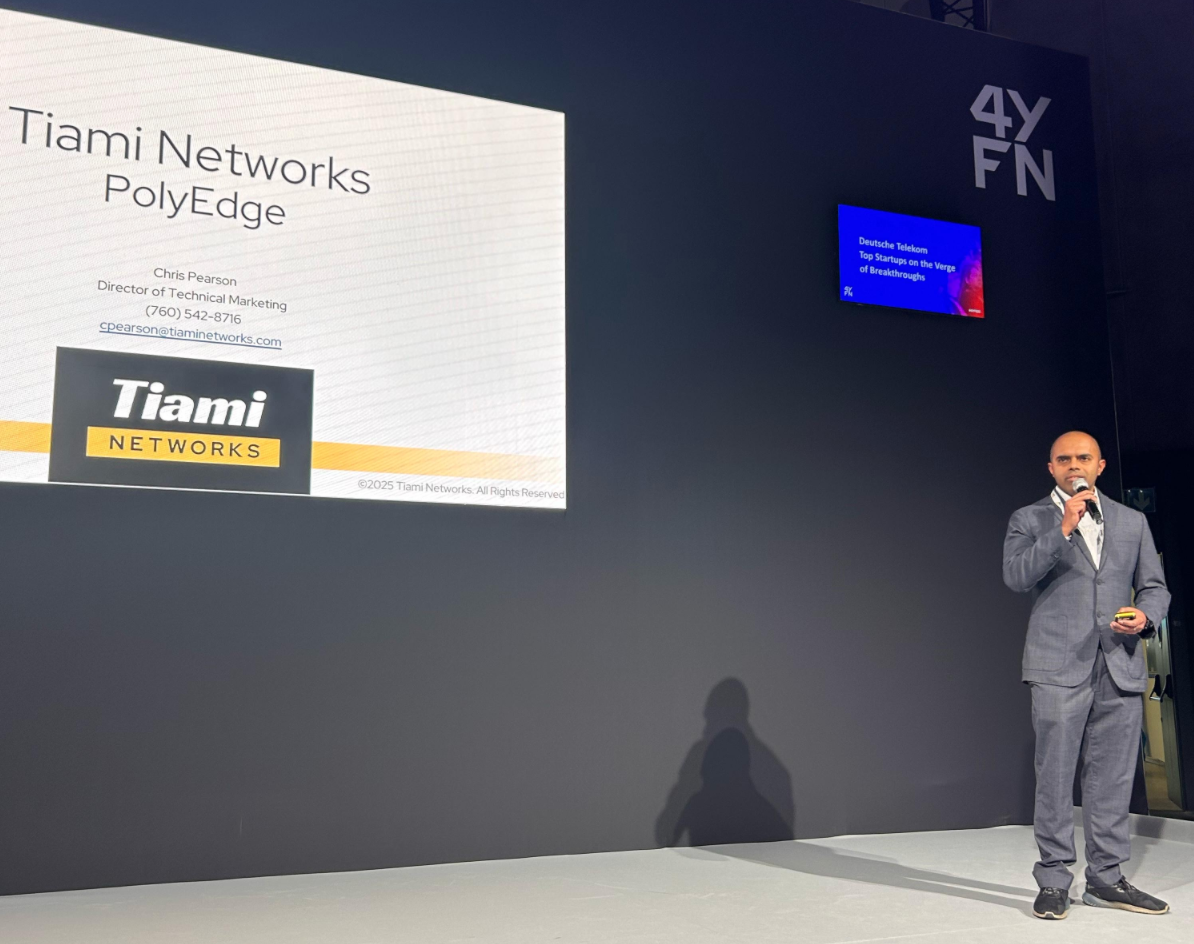
We were honored to exhibit in the 4YFN (4 Years From Now) hall, the heart of the startup ecosystem at MWC. A huge shoutout to our partners at hubraum for giving us the platform and support to be there. We couldn’t have asked for a better environment – the space was buzzing with energy all week. We also had the pleasure of being surrounded by some of the most forward-thinking companies around. Special thanks to our neighbors, especially the fantastic crew from IS-Wireless – the camaraderie, shared insights, and impromptu hallway brainstorms made each day that much better.
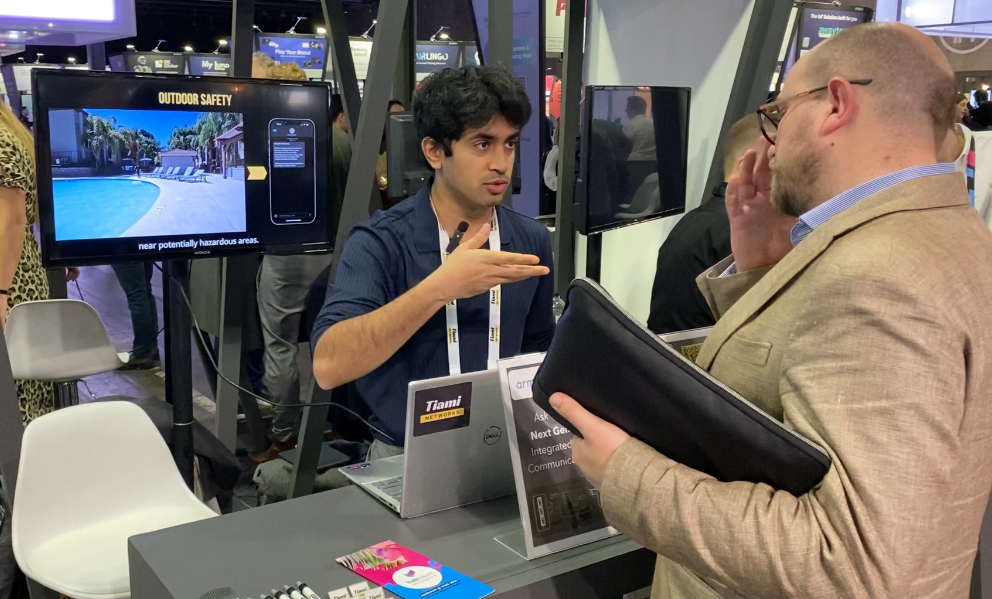
One of the highlights of the week was our involvement with the AI-RAN Alliance, where we were proud to be part of a demo at the ARM booth. There, we demonstrated how PolyEdge’s person detection capabilities can be deployed directly at the RAN level – a bold step toward realizing the full potential of Integrated Sensing and Communications (ISAC) in real-world 5G (and future 6G) environments. This capability helps bring intelligence closer to the edge, enabling ultra-low latency sensing applications and smarter network behavior in dense, dynamic environments.
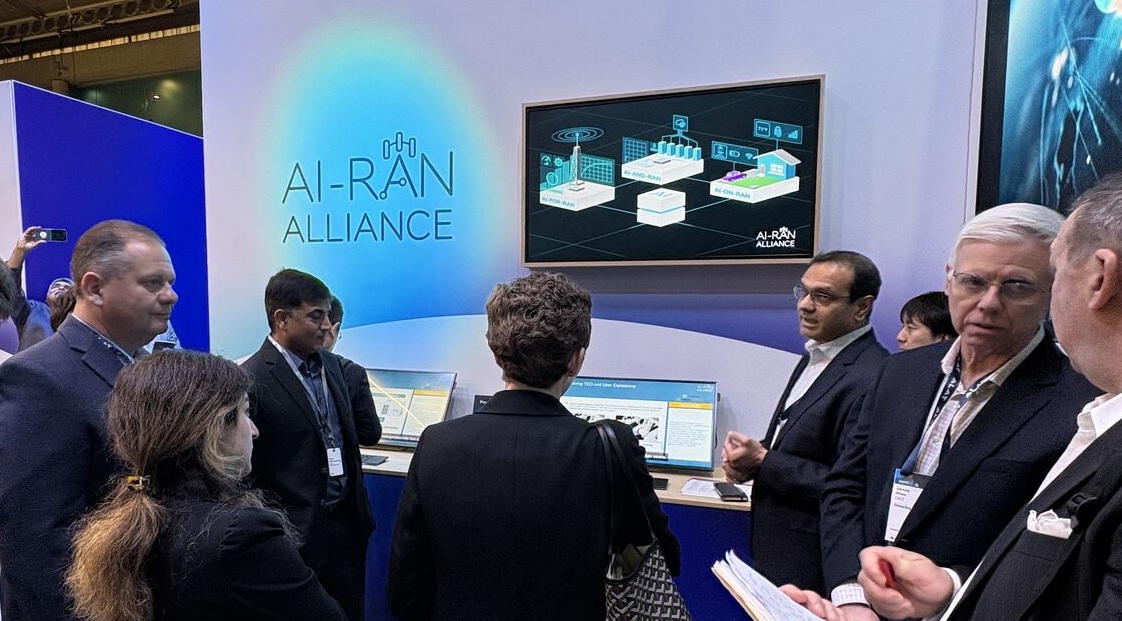
We also spent valuable time with our close collaborators at Airspan. Ahead of MWC, we formally signed an MoU (Memorandum of Understanding) with them to explore joint development of ISAC-powered RAN solutions. At the show, we took the opportunity to celebrate that milestone and reflect on how our technologies, when combined, are helping reshape the future of wireless infrastructure. Airspan’s vision for a programmable, software-defined network aligns beautifully with our approach to multi-functional sensing, and we’re excited for what lies ahead.
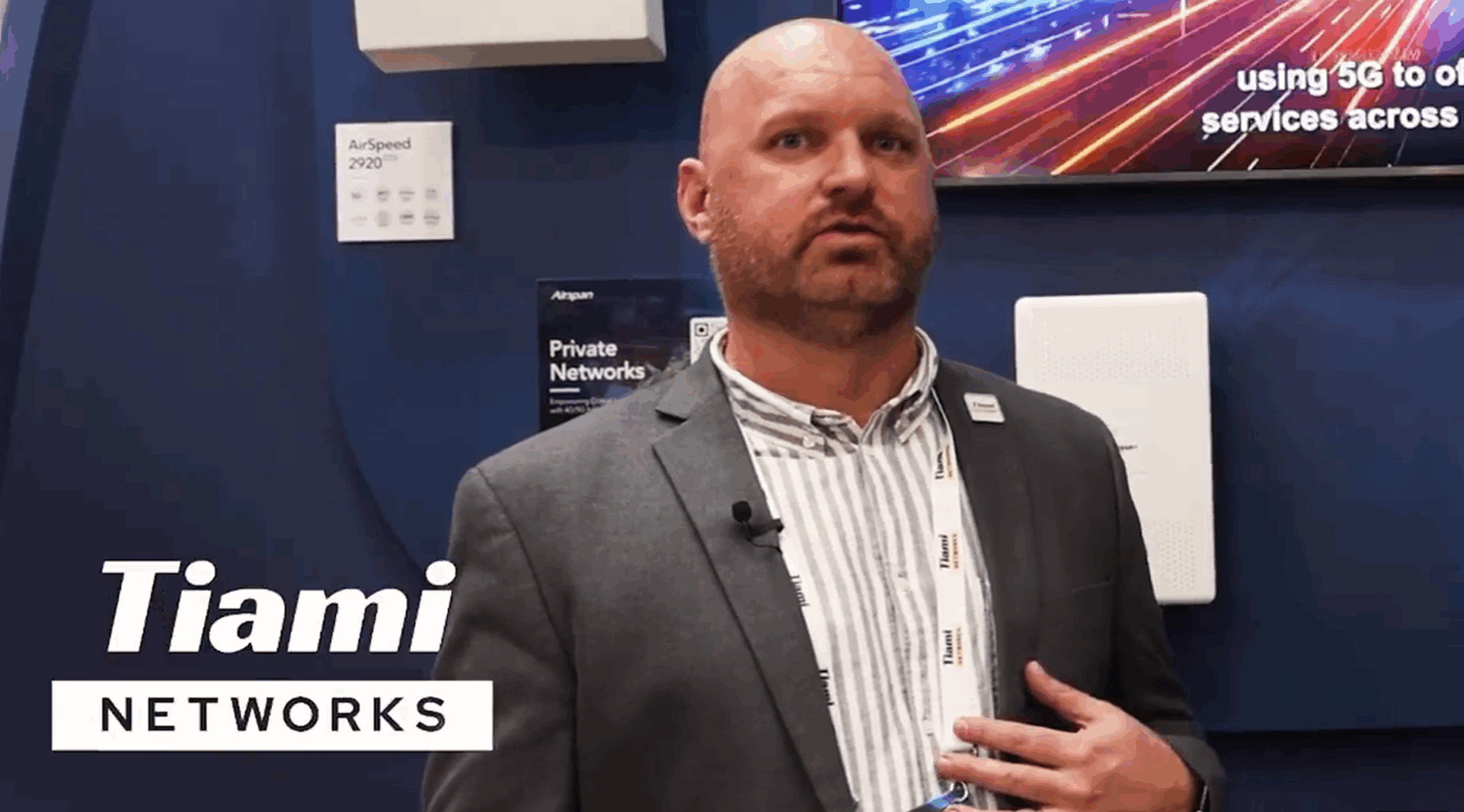
Of course, MWC wouldn’t be complete without engaging with the people who make the industry what it is. We had fantastic conversations with existing customers, sharing progress updates and exploring new use cases, as well as with potential new partners and leads – some of whom we met for the first time on the show floor. The energy, curiosity, and ambition of this community were truly inspiring.
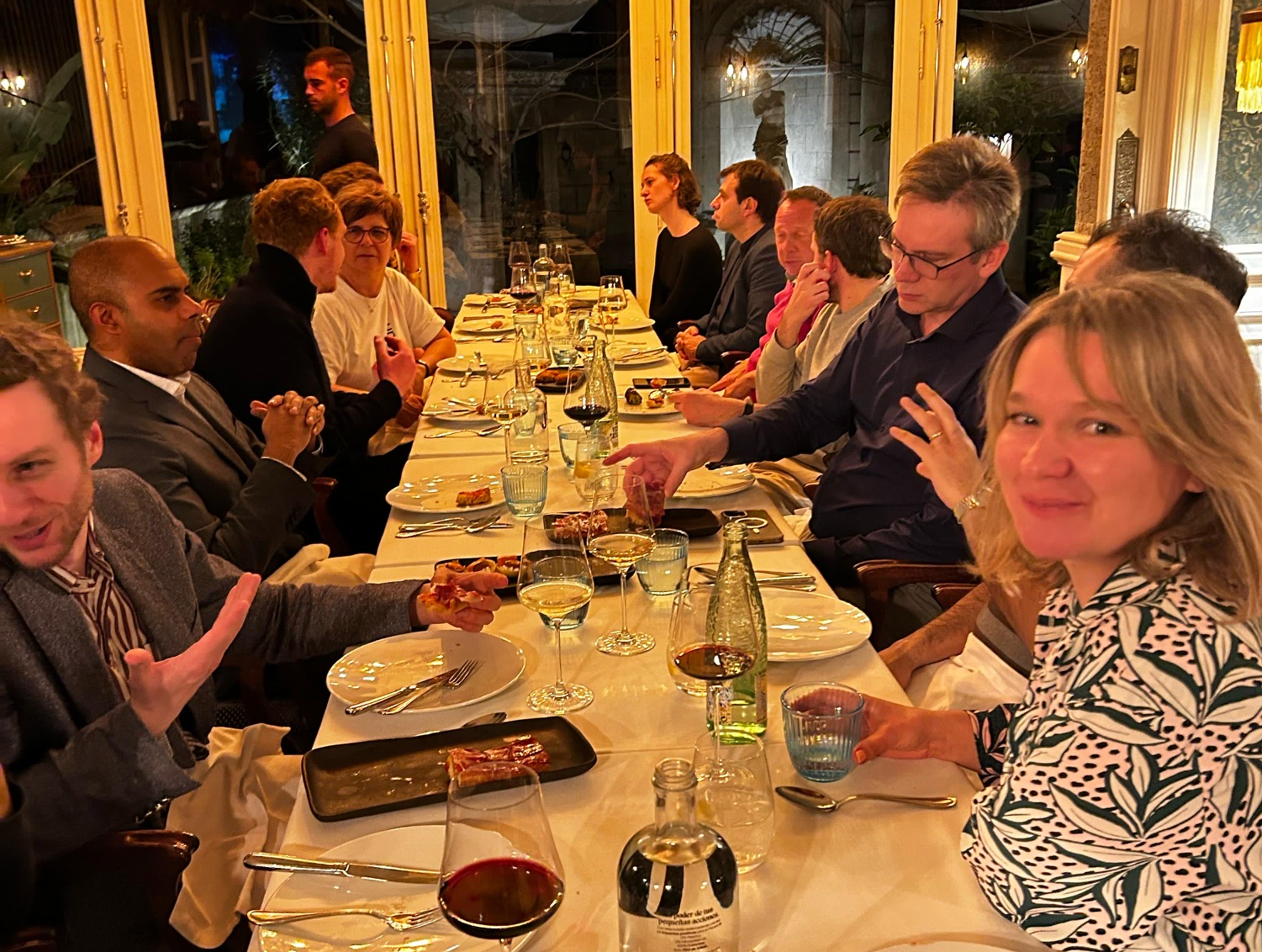
Our team left Barcelona full of new ideas, strong connections, and a renewed sense of purpose. Events like MWC remind us why we do what we do – and why PolyEdge and our broader platform continue to resonate across defense, infrastructure, smart cities, and beyond.
We’re incredibly grateful to everyone who made time to connect with us – whether at our booth, the ARM pavilion, or during a late-night tapas run.
Thank you, Barcelona. Thank you, MWC. Onward and upward.
Tiami Networks and Airspan Announce Expanded Partnership to Pave the Way for 5G and 6G Innovation
[February 24, 2025; Sacramento, California] – Tiami Networks, a leader in Integrated Sensing and Communications (ISAC), and Airspan Networks, a pioneer in end-to-end wireless solutions, are pleased to announce the signing of a Memorandum of Understanding (MOU) to expand their strategic partnership. This innovative collaboration, following a successful joint demonstration at MWC Vegas, marks a significant leap forward in advancing next-generation wireless technologies, particularly 5G-Advanced and future 6G networks.
During MWC Vegas, the two companies demonstrated the seamless integration of Tiami Networks' PolyEdge Multifunction Sensor and ISAC capabilities with Airspan Networks' 5G end-to-end solutions, delivering a fully functioning 5G network with built-in ISAC capabilities. This groundbreaking demonstration showcased the first instance of ISAC capabilities being natively integrated into a commercially available 5G solution, while setting the stage for future advancements in 5G and 6G communications.
Building on this success, Tiami Networks and Airspan Networks are committed to pushing the boundaries of wireless innovation. The expanded partnership will focus on the continued development and deployment of next-generation solutions that enhance network resilience, improve spectrum efficiency, and enable advanced sensing capabilities for a wide range of applications.
“We are thrilled to deepen our collaboration with Airspan Networks as we jointly lead the charge towards the next wave of wireless innovation,” stated Amitav Mukherjee, CEO of Tiami Networks. “Our combined expertise positions us to play a pivotal role in shaping the future of 5G and 6G, offering unparalleled value to our customers and partners.”
"This Memorandum of Understanding with Tiami Networks solidifies our shared commitment to advancing next-generation wireless technologies," stated Glenn Laxdal, President and CEO at Airspan Networks. "By combining Airspan's cutting-edge RAN solutions with Tiami’s expertise in 5G-based sensing and tracking technologies, this partnership will pave the way for innovative applications that demonstrate the transformative potential of integrated communications and sensing for 5G and future 6G networks."
Airspan and Tiami will both be at MWC Barcelona (March 3-6). To learn more about ISAC and our latest 5G solutions visit Airspan in Hall 2, Booth 2E20 and Tiami Networks in Hall 8, Booth 8.1B44.8.
Recap of an Exciting and Productive MWC Vegas 2024 for Tiami Networks
It’s been over a month since Mobile World Congress (MWC) Vegas, so we thought now was a good time to reflect on our time at the show and it’s safe to say this year’s event was a tremendous success for Tiami Networks! From connecting with industry leaders to showcasing our latest technology, MWC Vegas offered us the ideal platform to share our vision and make meaningful strides toward future partnerships and growth. Read along for a recap of the highlights.
Tiami Networks on the Show Floor
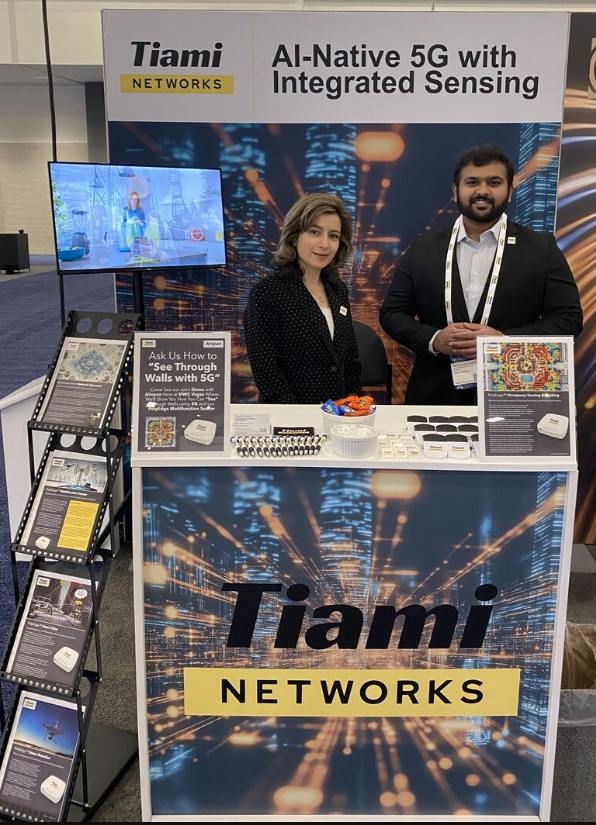
Our booth on the show floor provided a great space to engage with attendees, share insights about our innovative technology, and demonstrate our commitment to advancing telecommunications. We were thrilled by the enthusiasm and curiosity we received from visitors and industry experts alike. Our team enjoyed insightful discussions about the future of Integrated Sensing and Communications (ISAC), occupancy detection, and real-time network analytics, with a constant stream of guests stopping by to learn more about our PolyEdge Multifunction Sensor and explore potential applications.
A Collaborative Demo with Airspan
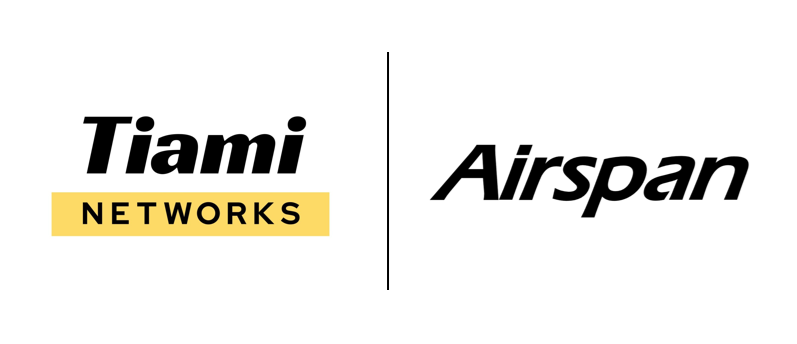
A major highlight of the event for us was our joint demonstration with Airspan. Held in Airspan’s executive meeting room, this demonstration showcased the integration of Tiami’s PolyEdge Multifunction Sensor with Airspan’s software-defined radio, delivering a fully functional 5G network with built-in ISAC capabilities. Together, we demonstrated how Tiami can transform traditional network infrastructure, enabling applications like precise occupancy sensing, UAS tracking, and more. The live demo was met with excitement from attendees, and we couldn’t be more pleased with the positive response!
If you didn’t get a chance to join us in Vegas we encourage you to watch this video of our demo created in partnership with our friends at Airspan.
Productive Meetings and Promising Leads
Beyond the demonstrations, MWC Vegas provided an invaluable opportunity for us to connect with industry stakeholders, partners, and potential customers. We had a series of productive meetings, many of which opened doors for new projects and collaborations. From discussions with existing clients to introductions to key players in the telecom space, these conversations left us energized and optimistic about what’s next for Tiami.
Building Connections and Networking with Industry Leaders
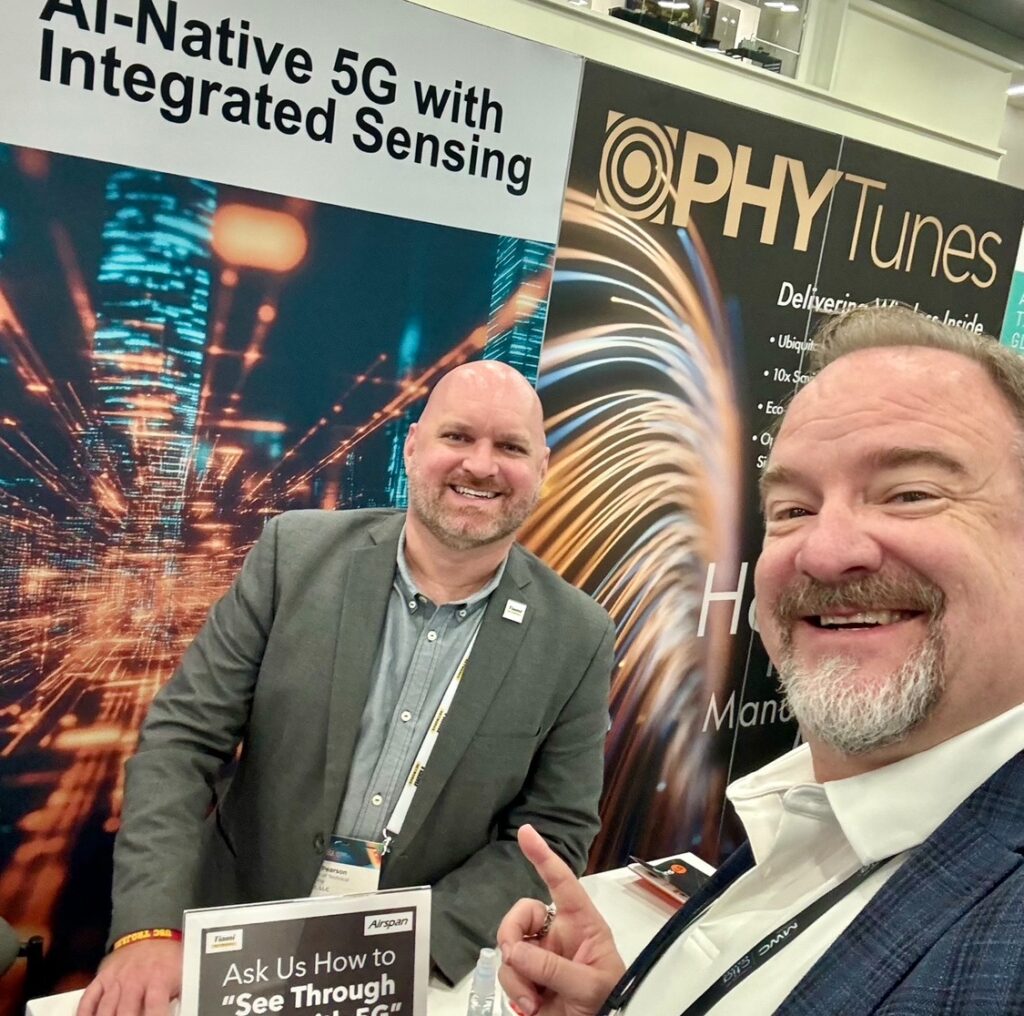
MWC Vegas is renowned for its networking opportunities, and this year was no exception. We connected with innovative companies, exchanged ideas with experts in the field, and met passionate professionals who share our commitment to advancing the telecommunications landscape. Each conversation reinforced our belief in the importance of collaboration as we look to drive impactful change in areas like resilient communications, smart cities, and environmental sensing.
Looking Ahead
MWC Vegas was an incredible experience for Tiami Networks, providing us with invaluable exposure, deepened relationships, and fresh opportunities. We’re grateful for everyone who visited our booth, joined us for the demo, and shared their insights with us. We look forward to turning these connections into lasting collaborations and using the momentum from MWC Vegas to drive innovation forward.
Thank you, MWC Vegas, for a fantastic show! Stay tuned for more updates from Tiami Networks as we continue to push the boundaries of what’s possible in telecommunications and stay tuned to hear about our plan for MWC Barcelona 2025!
Leveraging PolyEdge for Traffic and Pedestrian Detection in Smart Cities: A New Era for Urban Mobility
As cities evolve into smart ecosystems, the need for cutting-edge solutions that enhance safety, optimize traffic flow, and improve urban mobility has never been greater. Our PolyEdge Multifunction Sensor is at the forefront of this transformation, offering advanced capabilities that integrate seamlessly with the fabric of smart cities.
Our technology harnesses wireless signals such as 5G, 4G, and Wi-Fi to provide real-time traffic and pedestrian monitoring, driving critical insights that enhance urban planning and day-to-day city management. In this blog post, we’ll explore how PolyEdge can revolutionize Smart Cities by reshaping how they approach traffic flow and pedestrian safety.
Advanced Traffic Flow Monitoring
Smart Cities require real-time data to make informed decisions about traffic management, and this is where our PolyEdge Multifunction Sensor comes into play. By using ambient wireless signals, PolyEdge can detect vehicles as they move through the city’s streets. We use proprietary AI/ML algorithms operating on an edge device to process this data in real-time, delivering insights into traffic density, speed, and patterns.
This data allows city planners and administrators to:
- Optimize traffic light timings to reduce congestion.
- Detect and respond to bottlenecks in real-time, improving road safety.
- Reroute traffic dynamically to minimize delays and enhance the overall flow of vehicles through urban centers.
In addition to all that PolyEdge doesn’t rely on cameras for detection, making it a privacy-conscious solution that fits into the fabric of smart city infrastructure.
Pedestrian Detection for Enhanced Safety
The safety of pedestrians is paramount in any smart city initiative. With PolyEdge, cities can ensure that pedestrians are detected accurately at key intersections, crosswalks, and public spaces.
This real-time data can be used to:
- Automatically adjust crosswalk signals to give pedestrians priority during busy hours.
- Monitor foot traffic in real-time, ensuring that areas with high foot traffic receive the necessary attention in terms of infrastructure and safety measures.
- Alert authorities about potentially dangerous situations like jaywalking or individuals crossing in high-risk areas.
The use of non-visual sensing through wireless signals gives PolyEdge a unique edge, making it an ideal solution for cities seeking advanced pedestrian detection without relying on cameras.
Environmental and Smart Infrastructure Insights
Beyond vehicles and pedestrians, PolyEdge can provide data on environmental conditions and support the development of smart infrastructure. Imagine lighting systems that automatically adjust based on the presence of people or vehicles, ensuring both energy efficiency and public safety.
PolyEdge's occupancy detection capabilities allow for innovative applications, such as:
- Smart lighting controls that brighten only when people or vehicles are detected.
- Adaptive urban spaces that adjust infrastructure based on real-time data from the PolyEdge sensors.
Tiami Networks remains committed to revolutionizing urban spaces by delivering real-time, actionable data that drives safety and efficiency. We believe our PolyEdge Multifunction Sensor will play an increasingly central role in the development of Smart Cities across the globe.
Stay tuned for updates on how PolyEdge can help cities take a bold step toward smarter, safer urban living.

Exploring the New Frontier of Smart Homes with PolyEdge, Matter, and hubraum
This year, we leveraged our time in hubraum's Wi-Fi Sensing Program to unlock new potential for our PolyEdge Multifunction Sensor in the smart home space. We've redefined smart home capabilities by integrating Wi-Fi sensing and the Matter IoT standard, offering a seamless, interoperable solution.
Our foray into smart homes with PolyEdge™ marks a significant milestone. The results underscore the versatility and future-proof nature of PolyEdge™. Whether it's for enhancing home security, optimizing energy usage, or facilitating elderly care, PolyEdge™ offers a robust and scalable platform.
The Wi-Fi Sensing Program at hubraum
Tiami Networks participated in hubraum’s Wi-Fi Sensing Program, where innovative solutions using Origin’s Wi-Fi Sensing API were developed to unlock the full potential of smart homes. This initiative focused on using Wi-Fi signals to detect motion, recognize gestures, and even measure biometrics in a privacy-centric, noninvasive way. With access to Deutsche Telekom's indoor testbed in Berlin, Tiami validated its PolyEdge Multifunction Sensor, integrating it with Wi-Fi sensing for smart home applications and exploring commercial scaling opportunities.
Innovation at Its Core
Smart homes have historically faced issues with device compatibility and human intervention, limiting their potential. Tiami's Wi-Fi and 5G sensing integration overcomes these barriers, allowing for real-time monitoring and intelligent automation. With Matter, smart home devices from various manufacturers can now work together seamlessly, enabling adaptive, responsive living environments.
For example, Wi-Fi sensing enables motion detection and automatically adjusts lights and HVAC systems as you move through your home. In outdoor scenarios where Wi-Fi strength may be limited, our proprietary smart switching algorithm leverages commercial 5G signals to detect unattended children near a pool or monitor the movement patterns of vulnerable individuals, providing real-time alerts.
Combining cutting-edge technology with Matter's universal standard ensures that PolyEdge is scalable and interoperable with a wide range of devices, creating a future-proof smart home ecosystem.
The Challenges in Existing Smart Homes
As smart devices become more common in households, two primary issues have come to the forefront:
1. Device Interoperability: While individual devices may be smart, they often operate within isolated ecosystems. A smart thermostat from one manufacturer may not communicate with a smart light from another, leading to a fragmented experience. This lack of compatibility and communication between devices hinders the seamless smart home experience that consumers desire.
2. Dependence on Human Inputs: Despite their advanced capabilities, many smart devices still require significant human intervention to operate effectively. Whether manually setting up routines, adjusting settings, or managing device interactions, users often find themselves in the loop more than they'd like.
These challenges highlight the need for a more unified approach to smart home technology that fosters interoperability and reduces the need for constant human oversight.
Our Solution: PolyEdge™ and the Matter IoT Standard
Our solution, PolyEdge™, is a groundbreaking framework that merges advanced Wi-Fi and 5G Sensing technologies with the Matter IoT standard. This integration is not just a step forward but a significant leap in creating a truly interconnected and intelligent home environment. It's the key to overcoming the obstacles in existing smart homes and unlocking their full potential.
What is Matter?
For those unfamiliar, Matter is the universal communication standard for IoT devices. It has generated buy-in from major tech giants like Google, Amazon, Apple, and Samsung. Matter is designed to ensure that devices from different manufacturers can seamlessly communicate and work together. By adopting Matter, we're breaking down the ecosystem barriers historically preventing smart devices from realizing their full potential.
Why Matter Matters
Several compelling factors drove our decision to integrate with Matter:
1. Scalability and Interoperability: By 2030, it's projected that there will be 5.5 billion Matter-compatible devices globally. This expansive ecosystem offers unparalleled opportunities for integration and scalability. By aligning with Matter, we ensure that our solutions are future-proof and widely accessible, making them compatible with many devices.
2. Industry Support: Matter has garnered support from some of the most influential players in the tech industry. The backing of companies like Google, Amazon, Apple, and Samsung provides a solid foundation for the ongoing development and adoption of the standard. This level of industry support assures us—and our users—that Matter will continue to evolve and improve, keeping pace with the market's needs.
3. Sustainability: Besides its technical advantages, Matter aligns with global efforts to reduce carbon emissions. The standard promotes energy efficiency by enabling devices to collaborate more intelligently, reducing unnecessary energy consumption. For Tiami Networks, integrating with Matter is not just about enhancing functionality—it's also about contributing to a more sustainable future.
The Role of Wi-Fi and 5G Sensing
Our solution is designed to create a more responsive and intelligent home environment, leveraging the advanced technology of Wi-Fi and 5G Sensing. These technologies are not just tools, but the fundamental building blocks of a system that can anticipate your needs and ensure your safety in real time.
- Wi-Fi Sensing uses Wi-Fi signals to detect motion and presence in the home, automating everyday tasks. Imagine returning home from work to find your lights and HVAC systems adjusted to your preferences without you having to lift a finger. Wi-Fi Sensing makes this a reality, enabling your home to anticipate your needs based on your behavior.
- 5G Sensing is a game-changer. This technology takes home automation to the next level by offering real-time monitoring and alerts. For example, if a child is detected walking unattended near a pool, our system can instantly alert the residents, ensuring quick action to prevent accidents. Similarly, 5G Sensing can monitor the movements of elderly or vulnerable individuals, providing caregivers with timely notifications and peace of mind.
- Adaptive Sensing: Our system intelligently switches between 4G, 5G, and Wi-Fi sensing on the fly, depending on signal strength and the specific scenario. This adaptability allows us to effectively sense and respond to the environment indoors and outdoors, ensuring consistent and reliable performance in various situations.
Conclusion
Integrating PolyEdge™ with the Matter IoT standard represents a significant step forward in the evolution of smart homes. By addressing the challenges of device compatibility and human dependency, our solution paves the way for a more connected, efficient, and intelligent living environment.
As we continue to innovate and expand the capabilities of our platform, we extend a warm invitation to partners from across the industry to join us in this journey. Your expertise and collaboration are crucial as we work together to revolutionize the future of smart homes, making them more intuitive, responsive, and sustainable than ever before.
Stay tuned as we continue to push the boundaries of what's possible in smart home technology. The future is intelligent, and with PolyEdge and Matter, it's only getting smarter. We're committed to this journey of innovation, and we're excited to see where it leads.
Resources
Tiami Networks and Airspan to Showcase 5G-Based Revolutionary Sensing and Object Tracking at MWC Las Vegas
[September 19, 2024; Las Vegas, NV] – Tiami Networks Inc, a leader in Integrated Sensing and Communications (ISAC) technology, is proud to announce a groundbreaking demonstration to be held at this year's MWC Vegas in partnership with Airspan Networks, a global provider of 4G and 5G Open RAN solutions.
Unlike traditional systems that rely on cameras, PolyEdge uses 5G waveforms as radar signals to detect and track objects like vehicles, drones, and people, even in challenging environments where cameras may fail. This technology allows for real-time monitoring without invading privacy, making it ideal for urban and rural areas alike.
This collaborative demonstration will showcase the seamless integration of Tiami Networks' technology with Airspan's state-of-the-art integrated radios, creating a fully functioning 5G network with ISAC capabilities built-in. Its advanced ISAC capabilities paired with Airspan's robust and flexible radio technology highlights an exciting use case for the future of 5G communications.
Key Highlights of the Demonstration:
- Integrated Sensing and Communications (ISAC): The PolyEdge Multifunction Sensor will exhibit its revolutionary 5G-based sensing system that enhances public safety and security through non-intrusive surveillance, integrated seamlessly with 5G communications to provide enhanced data transmission and connectivity.
- Airspan All-In-One Radios: Airspan's advanced all-in-one radio, with integrated Open RAN baseband, simplifies deployment by eliminating the need for external on-site compute. This solution delivers high-speed, reliable 5G connectivity, showcasing the power and potential of next-generation wireless networks while reducing complexity and accelerating deployment.
- Real-Time Applications: The demonstration will focus on real-world applications of this integrated technology, showcasing its potential for various applications including people counting and UAS detection.
"We are thrilled to partner with Airspan for this demonstration at MWC Vegas," said Amitav Mukherjee, CEO at Tiami Networks. "By combining our PolyEdge Multifunction Sensor with Airspan's innovative 5G solutions, we are setting a new standard for integrated sensing and communication technologies. This collaboration underscores our commitment to driving the evolution of wireless communications."
"This partnership with Tiami Networks allows us to showcase the capabilities of our RAN solutions," stated Glenn Laxdal, President and CEO at Airspan Networks. "This demonstration will provide a glimpse into the future of 5G networks, highlights how integrating advanced 5G-based sensing and tracking technologies can unlock new possibilities for wireless networks, delivering powerful, real-world applications."
The demonstration will take place at the MWC Vegas, from October 8 to October 10, at Airspan’s Executive Meeting Room (W208) – directions to which can be accessed at Tiami Network’s Booth #1535. Attendees will have the opportunity to witness live demonstrations, interact with experts from both companies, and explore the possibilities of this innovative technology integration.
Enhancing Drone Detection with Tiami Networks' PolyEdge™ Multifunction Sensor
In an era where unmanned aerial systems (UAS) or drones are becoming increasingly common, ensuring their safe and secure integration into our airspace is paramount. Whether for commercial, recreational, or military applications, the need for robust drone detection systems is more critical than ever. And our PolyEdge Multifunction Sensor is the perfect cutting-edge solution to meet the challenges of modern drone detection.
The Growing Need for Effective Drone Detection
Drones offer numerous benefits, from aerial photography and delivery services to agricultural monitoring and disaster response. However, their misuse poses significant risks, including privacy invasions, security threats, and potential collisions with manned aircraft. Effective drone detection systems are essential to mitigate these risks and ensure the safe operation of UAS in various environments.
Tiami’s PolyEdge Multifunction Sensor
The PolyEdge Multifunction Sensor is a state-of-the-art technology developed by Tiami Networks, leveraging our expertise in Integrated Sensing and Communications (ISAC). This innovative sensor is designed to provide comprehensive monitoring and detection capabilities, making it an ideal solution for drone detection applications. It uses proprietary machine learning algorithms operating on an edge computer.
Key Features and Benefits
One of the uses for PolyEdge is as a compact, self-powered sensor for 5G-Based Passive Radar System for Counter-UAS. It uses existing electromagnetic energy from high-power cellular transmitters and evaluates their echoes when reflected by a UAS for target detection and tracking.

Advanced Radar Sensing: The PolyEdge Multifunction Sensor utilizes cutting-edge radar sensing technology via 5G and Wi-Fi, enabling it to detect and track drones with high precision. This advanced sensing capability ensures reliable identification of UAS, even in challenging environments. This enables rapid identification and response to potential threats, enhancing situational awareness and security.
Jam-Resistant: Unlike most drone detection solutions PolyEdge doesn’t output radar signals. Rather, it uses cellular signals like 4G or 5G, or Wi-Fi, as signals of opportunity. It evaluates the echoes of UAS to determine their physical characteristics. Because of this important difference, our solution is resistant to the typical jamming that can be used to counter radar detection.
Versatility and Integration: The PolyEdge Multifunction Sensor is highly versatile and can be easily integrated into existing security and monitoring systems. Its multifunctional design allows it to serve various applications, from critical infrastructure protection to public safety and beyond.
Weather-independent Surveillance: Because PolyEdge uses electromagnetic spectrum it isn’t affected by weather the way a camera-based solution would be. This means that PolyEdge performs day or night in the sunshine or rain.
What frequencies do we use?
Our solution utilizes a 2-antenna FPGA operating in the 0.6 – 3.7 GHz range. With multiple network operators using 5G we have near-nationwide coverage in the US. OCONUS coverage is expected as 5G is deployed globally.
Applications of PolyEdge for Drone & UAS Detection
Airport Security: Ensuring the safety of airspace around airports is crucial. PolyEdge provides reliable detection of unauthorized drones, helping to prevent potential disruptions and enhance airport security measures.
Public Safety: Law enforcement agencies can utilize PolyEdge to monitor and detect drones in urban areas, ensuring public safety during large events and preventing unauthorized surveillance.
Critical Infrastructure Protection: Protecting critical infrastructure such as power plants, communication networks, and government facilities from potential drone threats is vital. PolyEdge offers robust monitoring capabilities to safeguard these essential assets.
Military and Defense: For military and defense applications, the PolyEdge Multifunction Sensor provides advanced detection and tracking of UAS, enhancing situational awareness and supporting mission-critical operations.
Conclusion
As the use of drones continues to grow, the need for effective detection systems becomes increasingly important. Our PolyEdge Multifunction Sensor offers a comprehensive solution for drone detection, combining advanced radar sensing, resistance to jamming, and ease of integration. With its versatile applications and cutting-edge technology, PolyEdge is poised to play a crucial role in ensuring the safe and secure integration of drones into our lives.
Explore the possibilities with the PolyEdge Multifunction Sensor and join us in enhancing drone detection for a safer future.
How Integrated Sensing and Communications (ISAC) Could Double the Economic Value of Licensed Spectrum
As many of us know, in some ways (or more than some ways) 5G has been a bit of an economic letdown. It’s true that predictions may have been overly optimistic, but here at Tiami Networks we’re convinced that there’s still plenty of value left to be had. We believe that Integrated Sensing and Communications (ISAC) is one of the keys to unlocking that as-of-yet unobtained value – both in densely and less-densely populated areas.
Clearly, the increasing demand for 5G services has pushed operators to maximize the use and value of their licensed spectrum. A significant way to do that is by integrating radar sensing capabilities (ISAC) into 5G networks. This innovation not only optimizes communication but also unlocks new revenue streams and applications. The best part is – you don’t have to wait for 6G – at Tiami we’re doing this today!
The Value of Licensed Spectrum
First, some background – licensed spectrum, particularly low-band, is a precious resource due to its superior propagation characteristics and coverage. Despite the high costs, such as the notable $140.1 billion peak in 2021 for spectrum allocations, the economic justification lies in its potential for broad and reliable 5G deployment. According to a report from the Global mobile Suppliers Association (GSA), low-band spectrum has been fetching high prices due to its ability to support extensive network coverage with fewer base stations. In fact, on a global basis, operators are actually paying a higher average price per MHz per population block (price/MHz/POP) for low-band spectrum than for their midband holdings.
Enhancing Spectrum Value with Radar Sensing in Densely Populated Areas
Integrating radar sensing into 5G networks transforms the spectrum from a single-purpose to a multi-purpose asset. This approach, employed by our PolyEdge™ solution, uses existing 5G infrastructure for both communication and sensing, thus increasing its utility and economic value.
- Improved Network Efficiency: Radar sensing allows for better network management and optimization, reducing downtime and maintenance costs by providing real-time environmental data.
- New Applications and Revenue Streams: The integration enables various applications like autonomous vehicle navigation, drone management, and smart city infrastructure monitoring. These applications create new business opportunities and revenue streams for operators.
- Enhanced Public Safety and Services: By leveraging radar sensing, 5G networks can support advanced public safety applications, such as disaster response and traffic management, thereby increasing the social value of the spectrum.
Rethinking Price per MHz per POP
It’s easy to understand why prices would be higher in more densely populated areas. But integrated sensing and communications has the potential to vastly increase the value of spectrum that doesn’t service highly populated areas. A great example might be a smart warehouse that’s in a rural location – sure there may not be a high population in the area but all those smart devices and pieces of automation equipment have the potential to be connected to the network.
We’re also seeing interest in places where national security objectives are paramount. You might imagine a nation’s border that isn’t heavily populated – but uses devices like unmanned aircraft systems to increase security and safety. Again, here is a place where the old paradigm about spectrum price is likely to shift.
Conclusion
Integrating radar sensing with 5G not only enhances the technical capabilities of networks but also significantly increases the economic value of licensed spectrum, both in heavily populated areas and less populated ones.
By transforming a communication asset into a multi-functional tool, operators can justify the high costs of spectrum acquisition while opening new avenues for innovation and revenue – in both urban and rural areas.
References For more insights into the economics of 5G spectrum, refer to the detailed report by RCR Wireless here.
Building Trust in Tech: How Our Occupancy Tracking Solution Respects User Privacy
In recent months, the FCC fined major U.S. wireless carriers nearly $200 million for sharing user location data without consent. This significant event highlights growing concerns around privacy and the misuse of personal data in the tech industry. As a startup focused on integrated sensing and communications (ISAC) solutions, we understand the importance of maintaining user trust through stringent privacy standards. In this blog post, we will discuss how our innovative approach to occupancy tracking and geotagged footfall data respects user privacy, juxtaposed against those recent FCC violations.
The FCC Violations: A Breach of Trust
The FCC's investigation revealed that these carriers sold real-time location data of their customers to third-party aggregators without obtaining proper consent. Despite being aware of unauthorized access, the carriers continued their practices, compromising user privacy and violating Section 222 of the Communications Act, which mandates the safeguarding of customer information. The severity of these actions underscores the need for ethical data handling and robust privacy measures in technology solutions.
Our Commitment to Privacy: A New Standard in ISAC
At Tiami Networks, we are committed to leveraging ISAC technology in a manner that prioritizes user privacy. Our occupancy tracking and geotagged footfall data solutions are designed with the following principles in mind:
Anonymized Data Collection:
Unlike the practices scrutinized by the FCC, our systems collect data that is completely anonymized. We do not track or store individual user identities or specific location data that can be traced back to a person.
Edge Computing for Enhanced Privacy:
Edge computing processes data locally on devices rather than transmitting raw data to central servers – which is one of the reasons we’ve chosen to employ it in our PolyEdge solution. This method not only reduces latency (which is great from a technical standpoint) but also minimizes the risk of data breaches by keeping sensitive information closer to the source (which is wonderful from a privacy aspect).
No Collection of Personally Identifiable Information (PII):
Our solutions can be implemented in a variety of ways in different industries, but no matter how they’re used they simply don’t collect personally identifiable information. This is a major step forward in an industry that hasn’t always been focused on protection people’s data.
Advanced Encryption Techniques:
All data transmitted within our system is encrypted using state-of-the-art techniques, ensuring that any data that is collected cannot be intercepted or misused.
Ethical Data Use: Our Differentiator
In light of the FCC’s findings, it is clear that ethical data use is not just a regulatory requirement but a fundamental business imperative. Our approach differentiates us from traditional models that prioritize data monetization over user privacy. By adhering to stringent privacy standards, we not only comply with legal requirements but also build a stronger relationship with our users and our customer’s users based on trust and respect.
Looking Forward: Building a Privacy-First Future
As the tech industry grapples with the implications of the FCC fines, it is evident that the future belongs to solutions that respect user privacy. Our occupancy tracking and geotagged footfall data solutions exemplify how ISAC technology can be harnessed responsibly. By prioritizing anonymized data, obtaining clear consent, leveraging edge computing, and employing robust encryption, we are setting a new standard for privacy in the tech industry.
While the recent FCC fines serve as a cautionary tale for the misuse of user data, they also highlight the critical importance of privacy-focused innovation. At our startup, we are proud to be at the forefront of this movement, ensuring that our solutions not only meet but exceed the expectations for ethical data use.

Conclusion
The tech industry is at a crossroads where user privacy cannot be compromised. By juxtaposing our privacy-first ISAC solutions against the recent FCC violations, we demonstrate our commitment to ethical innovation. Join us in building a future where technology respects and protects user privacy, setting a benchmark for trust in the digital age.
For more information about our privacy-focused solutions, please contact us at founders@tiaminetworks.com.
References
- The Hill, “AT&T, Verizon, T-Mobile hit with $200M FCC fine for sharing user location data without consent“
https://thehill.com/policy/technology/4630069-att-verizon-t-mobile-hit-with-200m-fcc-fine-for-sharing-user-location-data-without-consent/ - Bleeping Computer, “FCC fines carriers $200 million for illegally sharing user location”
https://www.bleepingcomputer.com/news/technology/fcc-fines-carriers-200-million-for-illegally-sharing-user-location/
Tiami Networks Wins "Most Integration Potential" Award at Deutsche Telekom's T Challenge for Innovative Generative AI Solution
[June 21, 2024; Elk Grove, California] – Tiami Networks, a pioneering startup in telecommunications technology, is proud to announce that it has been awarded the prestigious "Most Integration Potential" award at Deutsche Telekom's most recent T Challenge. The competition, which focused on AI for Telecommunications, recognized Tiami Networks for its groundbreaking solution, High-Dimension Diffusion for Real-Time Network Analytics using Generative AI.
The T Challenge is an annual innovation competition hosted by Deutsche Telekom, aimed at identifying and promoting cutting-edge technological advancements in the telecommunications sector. This year’s challenge centered on leveraging Generative AI to enhance wireless telecommunications, attracting participants from around the globe.
Tiami Networks' award-winning solution showcases the company's commitment to pushing the boundaries of what's possible in wireless technology. The solution utilizes generative diffusion models to optimize and enhance the performance of 5G networks, ensuring faster, more reliable, and more efficient connectivity for users. It features data-driven joint characterization of hundreds of KPIs for a global view of the network, flexible forecasting, the ability to zoom in and out of the network with ease, straightforward recalibration, generative high-dimensional diffusion, and deployment on 3GPP Release 16 Network Data and Analytics Function (NWDAF) for truly real-time analytics.
“We are incredibly honored to receive this recognition from Deutsche Telekom,” said Amitav Mukherjee, CEO of Tiami Networks. “This award is a testament to the hard work and dedication of our team, as well as our innovative approach to integrating Generative AI within 5G systems. We are excited about the potential this solution holds for transforming wireless telecommunications and are eager to collaborate further with Deutsche Telekom to bring this technology to market.”
As the winner of the "Most Integration Potential" award, Tiami Networks will receive mentorship and support from Deutsche Telekom, along with opportunities for potential pilot projects and collaborations. This recognition not only validates Tiami Networks' innovative capabilities but also paves the way for significant advancements in the telecommunications industry.
“AI has the power to make network ecosystems drastically more efficient and we're on a mission to find the best solutions,” stated John Saw, EVP & CTO at T-Mobile. “That's where our T Challenge competition comes into play! This year's participants are paving the way for the future of telecom with their AI solutions. Congratulations to Tiami Networks for winning the Most Integration Potential award.”
Tiami Networks is dedicated to driving the future of telecommunications through continuous innovation and strategic partnerships. The company looks forward to leveraging this achievement to further enhance its technological offerings and contribute to the evolution of wireless communication.

About Tiami Networks
Founded by seasoned professionals from renowned telecom giants such as Ericsson, Verizon, Qualcomm, and Nokia, Tiami Networks is a visionary startup based in California. With deep-rooted expertise in telecommunications, our team is dedicated to revolutionizing the global 5G landscape. Our mission is to transform the 5G system into the world’s largest distributed radar network, harnessing this technology for consumer and commercial applications. By integrating advanced AI and radar technology with 5G networks, Tiami Networks aims to create smarter, safer, and more efficient environments, enhancing connectivity and data analysis capabilities across various sectors. Our commitment to innovation positions us at the forefront of the next wave of technological advancements, poised to redefine the future of communication and environmental intelligence. Learn more at www.tiaminetworks.com
About Deutsche Telekom's T Challenge
Deutsche Telekom's T Challenge is an annual innovation competition designed to foster technological advancements in telecommunications. By bringing together startups, developers, and innovators from around the world, the T Challenge aims to drive innovation and enhance the future of telecommunications services and infrastructure. Learn more at www.telekom-challenge.com
Forward-Looking Statements
This press release contains forward-looking statements that are subject to the safe harbors created under the Securities Act of 1933 and the Securities Exchange Act of 1934. Forward-looking statements include, among others, statements that refer to the features, benefits and performance of Tiami Networks’ generative AI solutions. Readers are cautioned that actual results could differ materially from those expressed in any forward-looking statements. Factors that could cause actual results to differ include: contractual problems; our ability to successfully develop, introduce and sell new technologies, products and services; the effect of adverse regulatory changes on our ability to sell or deploy our products and services; and other factors affecting the telecommunication sector generally. Readers are cautioned not to place undue reliance on any forward-looking statements, which speak only as of the date on which they are made. We undertake no obligation to update or revise any forward-looking statements for any reason.
For more information, please contact:
Chris Pearson
Director of Technical Marketing
Tiami Networks
cpearson@tiaminetworks.com
Unlocking Innovation: Tiami Networks' Acceptance into hubraum's Tech Accelerator
Have you ever heard of hubraum? It's a German word whose closest English equivalent is probably "engine displacement," – which seems like an odd fit for the mission here at Tiami Networks.
Well, it means something else, too – it's the technology accelerator/incubator arm of Deutsche Telekom. And we're proud to have been admitted into their Wi-Fi Sensing Program. For startups like Tiami Networks, navigating the complex landscape of integrated sensing and communications requires more than just a great idea – it demands support, mentorship, and access to resources. That's where hubraum comes into play. In this blog post, we delve into our journey within Hubraum's ecosystem, exploring this unique program's challenges, opportunities, and possibilities.
The Genesis of Tiami Networks
Founded by a team of visionary entrepreneurs, Tiami Networks emerged from a shared passion for pushing the boundaries of connectivity and integrated sensing and communications. Recognizing the immense potential of this burgeoning field, we set out to develop cutting-edge solutions that bridge the gap between data acquisition and seamless connectivity. From smart cities and industrial automation to environmental monitoring and beyond, Tiami Networks aims to revolutionize how we interact with our surroundings.
Embracing the hubraum Experience
Gaining acceptance into hubraum's tech accelerator program marked a pivotal moment in Tiami Networks' journey. The opportunity to collaborate with Deutsche Telekom—a global leader in telecommunications—has so far opened doors to unparalleled expertise, resources, and market insights. From the jump, we’ve immersed ourselves in hubraum's vibrant ecosystem, seizing every opportunity to learn, iterate, and grow.
Mentorship and Guidance
One of the most valuable aspects of participating in hubraum's program is gaining access to experienced mentors and industry veterans. We are benefiting from personalized guidance on everything from product development and go-to-market strategy to fundraising and scalability. These mentors provide invaluable feedback, challenge our assumptions, and offer fresh perspectives that help us refine our vision and accelerate our progress.
Collaboration and Partnership
hubraum's emphasis on collaboration has fostered a spirit of innovation and camaraderie among participating startups. We’ve had the opportunity to collaborate with fellow entrepreneurs, exchange ideas, share resources, and form strategic partnerships. These collaborations enrich Tiami Networks' offerings and reinforce the sense of community within hubraum's ecosystem.

Access to Resources
Beyond mentorship and collaboration, hubraum provides Tiami Networks with access to a wealth of resources, including state-of-the-art facilities, funding opportunities, and technical support. Whether it’s access to cutting-edge equipment for prototyping or assistance with regulatory compliance, we’ve found the support we need to overcome obstacles and stay ahead of the curve.
Pilots and Validation
One of the most exciting aspects of Tiami Networks' journey in hubraum is the opportunity to conduct pilots and validation tests with Deutsche Telekom and its network of partners. These real-world deployments will provide invaluable feedback and validation, helping us fine-tune our solutions and demonstrate our value proposition to potential customers and investors.
Growth and Expansion
As Tiami Networks progresses through hubraum's program, we expect the impact of our innovations to become increasingly evident. From securing strategic partnerships to attracting investment, we’re planning rapid growth and expansion, fueled by the support and momentum gained from our participation in hubraum. With a growing customer base and a solid foundation for future growth, Tiami Networks is poised to make a lasting impact in the integrated sensing and communications space.
Conclusion: A Bright Future Ahead
In conclusion, Tiami Networks' journey to date in hubraum's tech accelerator program exemplifies the transformative power of collaboration, mentorship, and innovation. By leveraging the resources and expertise available within hubraum's ecosystem, we’ve accelerated our growth and contributed to the broader advancement of technology and telecommunications. As we continue to push the boundaries of what's possible, Tiami Networks serves as a shining example of the entrepreneurial spirit and ingenuity that defines the startup landscape. With hubraum's support behind us, the future looks brighter than ever for Tiami Networks.
Tiami Networks Announces Strategic Collaboration to Transform 5G Networks
February 22, Elk Grove, California - Today, Tiami Networks announces a strategic collaboration with Intel, a leader in computing innovation. This collaboration marks a significant milestone in Tiami Networks' quest to revolutionize 5G technology, transforming global 5G networks into the world's largest radar system.
"Elk Grove is proud to be at the forefront of this technological leap. Piloting PolyEdge™ for traffic flow monitoring is not just about embracing innovation; it's about actively contributing to a smarter, safer, and more efficient community," commented Darrell Doan, Economic Development Director, Elk Grove, California.
A New Era of Connectivity: AI + 5G + Radar on Edge Devices
The collaboration with Intel is pivotal in the development of PolyEdge ™, Tiami Networks' cutting-edge technology that combines AI, 5G, and radar capabilities on edge devices. Tiami employs state-of-the-art 5G signal processing and proprietary machine learning algorithms for sensing, enhanced by Intel’s cutting-edge FPGA artificial intelligence framework.
This innovative approach is set to redefine connectivity and data analysis, promising significant advancements in areas like public safety, environmental monitoring, and smart city initiatives. By providing real-time data analysis, PolyEdge ™ can help in efficient resource allocation, emergency response optimization, and even tracking environmental changes with unprecedented accuracy.
"Intel is excited to see Tiami Networks utilize our technology in a transformative way. This collaboration showcases the versatility of Intel's FPGA artificial intelligence solutions and paves the way for groundbreaking advancements in 5G capabilities," said Mike Fitton, Network Business Division, Intel.
Looking Ahead
This collaboration represents a leap forward in technological integration, combining the strengths of Tiami Networks' innovative vision and Intel's robust technological infrastructure. The initiative is poised to set new standards in connectivity and data analysis, offering transformative solutions for cities, industries, and societies worldwide. "This collaboration with Intel is a game-changer. It enables us to bring our innovative technology to market, transforming the way we understand and interact with our environment. We're creating a new paradigm where 5G networks do more than connect – they perceive and respond.", said Amitav Mukherjee, CEO of Tiami Networks
Connect and Learn More
Tiami Networks will be showcasing PolyEdge™ at Mobile World Congress in Barcelona from 26-29 February, 2024. Stop by Stand #6F48 and experience the future of 5G.
About Tiami Networks
Founded by seasoned professionals from renowned telecom giants such as Ericsson, Verizon, Qualcomm, and Nokia, Tiami Networks is a visionary startup based in California. With deep-rooted expertise in telecommunications, our team is dedicated to revolutionizing the global 5G landscape. Our mission is to transform the 5G system into the world's largest distributed radar network, harnessing this technology for consumer and commercial applications. By integrating advanced AI and radar technology with 5G networks, Tiami Networks aims to create smarter, safer, and more efficient environments, enhancing connectivity and data analysis capabilities across various sectors. Our commitment to innovation positions us at the forefront of the next wave of technological advancements, poised to redefine the future of communication and environmental intelligence. Learn more at www.tiaminetworks.com
About Intel
Intel (Nasdaq: INTC) is an industry leader, creating world-changing technology that enables global progress and enriches lives. Inspired by Moore’s Law, Intel continuously works to advance the design and manufacturing of semiconductors to help address our customers’ greatest challenges. By embedding intelligence in the cloud, network, edge and every kind of computing device, Intel unlocks the potential of data to transform business and society for the better. To learn more about Intel’s innovations, go to newsroom.intel.com and intel.com.
For more information, please contact:
Tiami Networks
Mr. Tyrell Junius
Email: tjunius@tiaminetworks.com
Intel
Mr. Bret Gustafson
Email: bret.gustafson@intel.com
PolyEdge Solution Brief: Mobile World Congress Barcelona Demo in Partnership with Intel
The Imperative of Strengthening Skilled Labor for National and Economic Security: A Lesson from History
Following Labor Day observation, a tribute to the labor force that forms the nation's core, the critical conversation around fortifying skilled labor in the 14 essential technology areas for national and economic security gains prominence. The Bureau of Labor Statistics estimates that between 2021 and 2031, jobs for cybersecurity analysts will grow by 35% and software developers by 25%, outpacing the average 5% growth rate. This forecast, however, juxtaposes alarmingly with the existing deficiency in skilled labor, forming a paradox that warrants scrutiny.
Fortune highlights that the specialized talent arena has evolved into a global battlefield. Initiatives in countries like the United Arab Emirates, Canada, and Australia, which offer STEM and Entrepreneur VISAs, demonstrate the aggressive strides taken to attract high-skill professionals. Notably, a National Foundation for American Policy study illustrates that 55% of the U.S.'s billion-dollar startups feature at least one immigrant founder. This evidence robustly dispels notions of immigration as an economic drain. Instead, it attests to the essential role immigrants play in fostering technological innovation and economic development in the country.
Mechanisms like the STEM Optional Practical Training (OPT) augment the capabilities of the private sector and the Defense Industrial Base (DIB) by including international STEM scholars. According to a 2019 Department of Homeland Security report, there were an estimated 223,284 international students in STEM OPT between 2008 and 2017, providing a significant talent pool.
"The OPT-to-permanent residency route is fraught with delays and a perilous H1-B lottery as an intermediate step," says Tiami founder Amitav Mukherjee. "Many of the applicants to our career openings are visa holders and require support for obtaining work authorization."
Despite solid progress in harnessing international talent, limited U.S. minority participation and historical barriers exist in STEM today. The National Science Foundation (NSF) published its report on diversity in science, technology, engineering, and mathematics. The report shows that there has been very little progress in increasing diversity in the STEM workforce from 2011-2021 shown below.
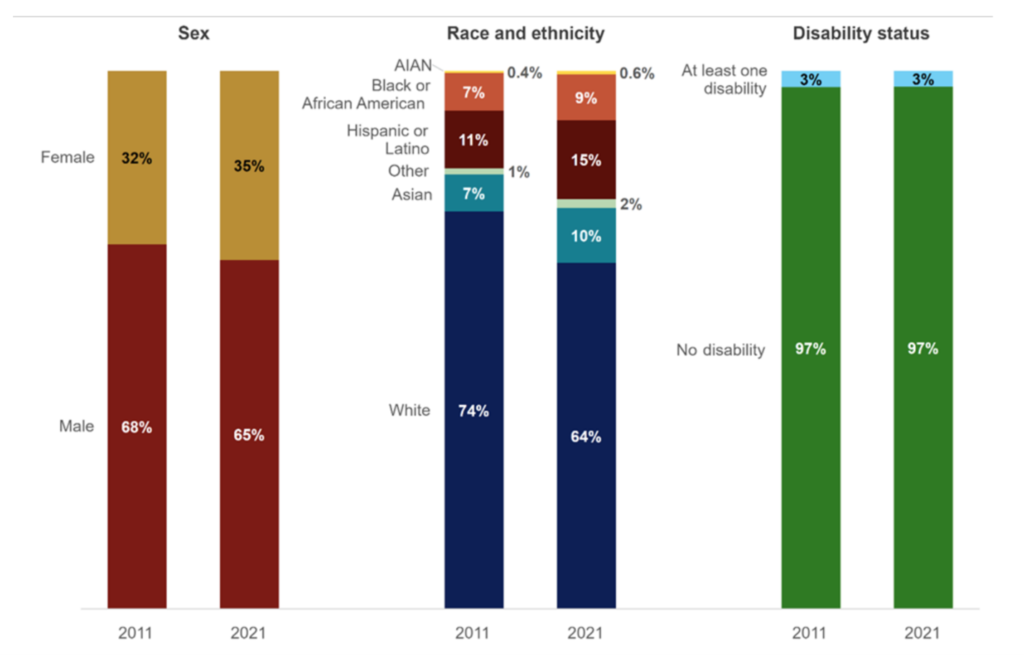
To tailor effective reforms, one must scrutinize historical and contemporary policies that have indirectly and substantially discouraged minorities from grasping growth opportunities in these pivotal sectors.
The Present Challenge: 14 Critical Technology Areas
The United States has judiciously identified 14 technology areas—from Artificial Intelligence to BioTech —as critical national security and development vectors. These domains command an amalgam of specialized skills and inventive thinking. The director of the Defense Innovation Unit (DIU), Doug Beck, stated during the Emerging Technology Defense Conference, “Talent is available, willing to relocate and take 90% pay cuts, but most of that talent lives in expensive cities, and hiring authorities need to move faster.” In light of Director Beck's cogent observations, it becomes manifestly clear that the onus of optimizing this reservoir of talent—eager yet geographically constrained—falls upon the acceleration of recruitment procedures within these crucial technological sectors.
The United States has undertaken precise actions to cultivate local talent. NASA and the U.S. Department of Education have recently signed a memorandum of understanding to enhance STEM education. These efforts aspire to broaden STEM career pathways and increase representation in these 14 critical technology sectors by focusing on diversity, equity, and inclusion. The state Michigan announced its plan to increase domestic microchip production through targeted investments for PreK-12 programs. Despite such progress, as highlighted in a Brookings article, the Creating Helpful Incentives to Produce Semiconductors and Science (CHIPS) Act, while notable, has its focus narrowly set on financial incentives and fails to address other crucial elements like mentorship, access to professional networks, and career services. This oversight could limit the full utilization of the Act in building a robust and diverse skilled labor force in technology areas vital to national security.
Given the above data, one could argue for a more comprehensive approach to labor force development. While initiatives like STEM OPT, the state of Michigan microchip production, and collaborations between NASA and educational departments are positive steps, the CHIPS Act reveals that gaps still exist in addressing the full range of needs for skilled labor force development from grades PreK-12 in historic underinvested neighborhoods.
The Past is Prologue: Title XI and Redlining
A nuanced understanding of the past is indispensable to address present challenges. Federal policies such as Title XI in education and redlining in housing have historically laid an uneven foundation, particularly impacting minority communities. Their ramifications persist today, contributing to the shortage of skilled labor in critical technology sectors.
Emerging from the Education Amendments of 1972, Title XI was designed to extirpate discrimination based on sex in educational programs subsidized by federal monies. However, its reach has been fundamentally constrained by pervasive social prejudices. According to the NSF, women comprise 28% of the STEM workforce. This underrepresentation is exacerbated among minority women. While Title XI had laudable aims, it failed to address the comprehensive barriers marginalized communities face. The limited reach of this policy manifests today as an acute shortage of domestic skilled labor in technology and engineering.
Tracing its roots to the 1930s, the practice of redlining saw federal agencies ascribing "credit risk" status to neighborhoods, a classification covertly correlated with racial composition. Financial inequities resulted in the denial of credit and financial infrastructure, pushing these locales into economic retrogression.
The National Community Reinvestment Coalition found that 74% of neighborhoods marked as hazardous ('redlined') in the 1930s were likelier to comprise low-income, minority communities today. Such systemic economic stagnation has, in turn, perpetuated a cycle of poor education and limited career opportunities. The Education Commission of the States shared that schools in high-poverty areas are less likely to offer advanced math and science courses that are often prerequisites for STEM careers. Lack of STEM investment in historically marginalized communities directly impacts the readiness of individuals from these communities to participate in high-growth sectors as future employees and business owners, including the 14 technology areas deemed critical for national security.
Both Title XI and redlining, although disparate in intent and focus, converge in their cumulative effect: they have restricted the access of minority communities to burgeoning fields essential for national wellbeing. It is not just an issue of social justice but national competence and security.
As we engage in discussions surrounding skilled labor shortages and national security, these historical policy failures must inform future strategies. The data points towards an inextricable link between past policies and present challenges. We must continue to examine how specific federal policies, such as Title XI education and redlining within the housing market, created and continue to enable an uneven playing field, particularly for minority communities. Comprehensive reforms rooted in understanding these systemic issues are needed to redress this gap effectively.
Room for Contemplation
While strengthening skilled labor is undeniably essential, proceeding with nuance is imperative. Some critics might argue that focusing on specialized skills could overlook other vital areas, such as healthcare and social services, which also face labor shortages. However, given China's threat of global competition, the CHIPs act was politically justified with bipartisan support. The U.S. Commerce Secretary Gina Raimondo called on students of every level of education to pursue careers in semiconductor manufacturing and related industries. Nonetheless, the nature of the 14 technology areas is such that advancements in them could invariably benefit these other sectors.
The gravity of bridging the skilled labor gap becomes apparent, not just as an economic necessity but as an imperative for national security. As we look forward to future Labor Days, it is incumbent upon policymakers, technologists, and public and private sector leaders to use this as an inflection point for change, leveraging historical lessons and data to devise holistic strategies that are inclusive and effective. Such camaraderie requires a holistic approach that draws lessons from the historical shortcomings of policies like Title XI and redlining while also keeping a keen eye on the future needs of the 14 critical technology sectors. The United States can only truly secure its domestic and global standing through such a concerted effort.

